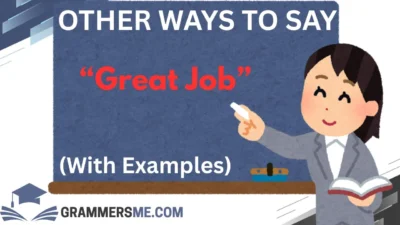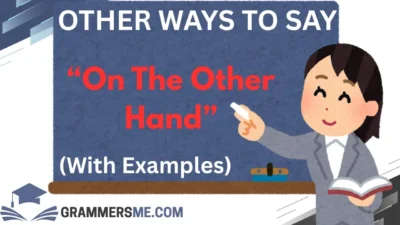Finding the right words to express ourselves, especially in professional or personal settings, can make all the difference. Whether you’re looking to convey warmth, offer reassurance, or simply communicate that you’re open and approachable, how we phrase things can deeply impact the tone of our messages.
This article explores 30 other ways to say “Happy to Discuss” that will help you connect more meaningfully with others. These alternatives will allow you to express your willingness to engage in conversations while sounding both professional and personal.
What Does “Happy to Discuss” Mean?
“Happy to discuss” is a phrase often used to express openness, readiness, and a positive attitude toward having a conversation. It conveys a willingness to talk about something, whether it’s a casual topic or a more serious matter. It shows that you’re approachable and that the person initiating the conversation can feel comfortable sharing their thoughts with you.
Is It Professional/Polite to Say “Happy to Discuss”?
Yes, “happy to discuss” is professional and polite. It’s a friendly, non-assertive way to indicate that you’re open to having a conversation. It’s especially appropriate in workplaces or formal communication when you want to invite dialogue without sounding too rigid or formal. It balances both approachability and professionalism, making it suitable for various contexts.
1. Looking Forward to Our Conversation
Meaning: This phrase conveys eagerness and anticipation for an upcoming discussion.
Explanation: It shows that you’re not just willing, but also excited to engage in the conversation.
Scenario Examples:
- “I’m looking forward to our conversation about the project update later today.”
- “I’m looking forward to our conversation about your new ideas for the campaign.” Best Use: When you want to express genuine interest and excitement.
Not Use: In very formal or strictly professional settings where a more neutral phrase is needed.
2. Eager to Chat
Meaning: Shows excitement and enthusiasm about having a conversation.
Explanation: It conveys that you’re interested in discussing a topic and open to hearing the other person’s thoughts.
Scenario Examples:
- “I’m eager to chat about the new marketing strategy.”
- “Let me know when you’re free; I’m eager to chat!” Best Use: In informal, friendly, or enthusiastic contexts.
Not Use: In overly formal or professional situations where a more subdued tone is needed.
3. Excited to Talk
Meaning: Indicates enthusiasm and positive anticipation for a conversation.
Explanation: This phrase communicates energy and eagerness, suggesting that you’re looking forward to a productive discussion.
Scenario Examples:
- “I’m excited to talk about the upcoming event!”
- “I’m excited to talk with you about this opportunity.” Best Use: When you want to share your enthusiasm in a professional or semi-formal setting.
Not Use: When the conversation topic is serious or formal and requires a more restrained approach.
4. Glad to Chat
Meaning: A polite and friendly way of expressing your willingness to talk.
Explanation: It’s a warm phrase that shows you’re available and happy to engage in a conversation.
Scenario Examples:
- “I’m glad to chat anytime you need help with that.”
- “It would be glad to chat with you about the proposal.” Best Use: In casual conversations where you want to appear approachable and kind.
Not Use: In highly professional or formal emails where a more neutral tone is required.
5. Open to Discuss
Meaning: This implies that you’re willing and receptive to talking about something.
Explanation: It’s neutral and professional, often used in business or formal settings to invite further discussion.
Scenario Examples:
- “I’m open to discuss any concerns you might have regarding the project.”
- “I’m always open to discuss ways to improve our processes.” Best Use: In formal or professional situations where you want to appear receptive and accommodating.
Not Use: In casual conversations where a friendlier or more enthusiastic tone is preferred.
6. Keen to Talk
Meaning: Expresses eagerness and interest in engaging in a conversation.
Explanation: It suggests a level of enthusiasm and genuine desire to communicate.
Scenario Examples:
- “I’m keen to talk about your upcoming event!”
- “I’m keen to talk more about your proposal and ideas.” Best Use: In friendly or semi-formal professional conversations where you want to sound engaged and proactive.
Not Use: When you want to maintain a completely neutral or formal tone.
7. Would Love to Chat
Meaning: An informal and warm expression that conveys excitement and willingness to talk.
Explanation: It’s more casual, ideal for informal settings, suggesting that you’d enjoy the conversation.
Scenario Examples:
- “I’d love to chat about your plans for the new website.”
- “I’d love to chat whenever you have the time.” Best Use: In casual, friendly settings where you want to sound approachable and easy-going.
Not Use: In formal or highly professional contexts where a more neutral or reserved tone is appropriate.
8. Happy to Have a Discussion
Meaning: A polite and professional way to express your openness to engaging in a conversation.
Explanation: This phrase balances warmth and professionalism, making it suitable for most contexts.
Scenario Examples:
- “I’m happy to have a discussion with you regarding the next steps in the project.”
- “We’re happy to have a discussion at your convenience.” Best Use: In professional or semi-formal conversations where you want to express both readiness and politeness.
Not Use: In overly casual situations where a more informal tone is preferred.
9. Available to Discuss
Meaning: Indicates that you are free and ready to talk.
Explanation: This phrase shows that you’re accessible and prepared to engage in a conversation at any time.
Scenario Examples:
- “I’m available to discuss the details of the new policy anytime this week.”
- “Feel free to reach out; I’m available to discuss your concerns.” Best Use: In professional and business settings when you want to make it clear that you’re approachable and accessible.
Not Use: In casual conversations where a warmer or more enthusiastic tone is appropriate.
10. Delighted to Talk
Meaning: A friendly and slightly formal phrase expressing happiness about having a conversation.
Explanation: This conveys a sense of positivity and warmth while maintaining professionalism.
Scenario Examples:
- “I’m delighted to talk about your feedback.”
- “I would be delighted to talk more about the proposal.” Best Use: In semi-formal or professional contexts where you want to express enthusiasm in a polite manner.
Not Use: In casual or very informal conversations where a simpler phrase would be better.
11. Glad to Have a Chat
Meaning: A warm and approachable phrase indicating that you’re happy to talk.
Explanation: It’s less formal than “happy to discuss” but still polite and friendly.
Scenario Examples:
- “I’m glad to have a chat whenever you have the time.”
- “I’m glad to have a chat with you about the new project.” Best Use: In more informal or semi-formal contexts when you want to sound friendly and available.
Not Use: In professional or formal communications where you might need a more formal expression.
12. Ready to Talk
Meaning: Indicates that you’re prepared and willing to engage in a conversation.
Explanation: This is a direct and neutral way to express your availability to talk about something.
Scenario Examples:
- “I’m ready to talk whenever you are.”
- “I’m ready to talk about any concerns you have.” Best Use: In professional contexts where you want to sound direct and approachable.
Not Use: In casual settings where a more enthusiastic or warmer tone might be better.
13. Looking Forward to Hearing From You
Meaning: A polite, slightly formal way of expressing anticipation for a conversation.
Explanation: This phrase shows that you’re waiting for a response or an invitation to talk.
Scenario Examples:
- “I’m looking forward to hearing from you about your ideas.”
- “We’re looking forward to hearing from you soon.” Best Use: In professional emails or formal communication when you want to express anticipation for a reply.
Not Use: In casual conversations, as it may sound too formal.
14. Pleased to Discuss
Meaning: A polite, slightly formal way of expressing that you’re happy to have a conversation.
Explanation: This phrase is often used in formal or professional settings to maintain a polite and respectful tone.
Scenario Examples:
- “I’m pleased to discuss the new developments with you.”
- “We would be pleased to discuss this further at your convenience.” Best Use: In formal communication when you want to express politeness and professionalism.
Not Use: In informal or friendly contexts where a simpler phrase might feel more genuine.
15. Eager to Hear Your Thoughts
Meaning: Expresses enthusiasm about hearing someone’s opinion or feedback.
Explanation: It shows that you value the other person’s thoughts and are eager to listen to them.
Scenario Examples:
- “I’m eager to hear your thoughts on this proposal.”
- “We’re eager to hear your thoughts about the changes.” Best Use: In professional contexts when you’re inviting feedback or discussing ideas.
Not Use: In casual settings where a more laid-back tone might be better.
16. Interested in Talking
Meaning: A neutral way of expressing a willingness to engage in a conversation.
Explanation: It implies you’re open and receptive to talking, without any pressure or excitement.
Scenario Examples:
- “I’m interested in talking about your project ideas.”
- “I’m interested in talking whenever you’re free.” Best Use: In professional or semi-formal situations where you want to sound neutral and open.
Not Use: In situations requiring enthusiasm or warmth.
17. Glad to Connect
Meaning: Expresses warmth and enthusiasm about having a conversation.
Explanation: This phrase is great for networking and professional interactions, signaling that you value the discussion.
Scenario Examples:
- “I’m glad to connect and discuss potential collaboration opportunities.”
- “It was a pleasure meeting you. I’m glad to connect and talk more soon!”
Best Use: In professional networking, business introductions, or LinkedIn messages.
Not Use: In formal business proposals or highly structured professional settings.
18. Available Anytime to Chat
Meaning: Indicates full availability and openness to a conversation.
Explanation: This phrase reassures the recipient that you’re flexible and easy to reach.
Scenario Examples:
- “I’m available anytime to chat if you have questions.”
- “Let me know what works for you—I’m available anytime to chat.”
Best Use: When offering an open-ended invitation for a conversation.
Not Use: When you need to set specific boundaries around your availability.
19. Let’s Discuss Whenever Convenient
Meaning: Politely suggests a discussion at the other person’s convenience.
Explanation: It’s a respectful way to invite a conversation without imposing a specific time.
Scenario Examples:
- “I’d love to hear your thoughts. Let’s discuss whenever convenient.”
- “No rush at all—let’s discuss whenever convenient for you.”
Best Use: In professional and courteous settings where you want to show flexibility.
Not Use: In urgent situations where a specific timeline is needed.
20. Happy to Go Over This With You
Meaning: Indicates willingness to review or explain something in detail.
Explanation: This phrase is helpful when offering guidance, support, or clarification.
Scenario Examples:
- “If you have any questions, I’m happy to go over this with you.”
- “Let’s set up a time—I’m happy to go over this with you in more detail.”
Best Use: When discussing reports, presentations, or complex matters requiring explanation.
Not Use: In informal conversations that don’t require a detailed review.
21. Willing to Discuss Further
Meaning: Shows openness to continuing or deepening a conversation.
Explanation: This phrase implies that you’re ready to engage in an in-depth discussion if needed.
Scenario Examples:
- “I appreciate your perspective, and I’m willing to discuss further if needed.”
- “I’m always willing to discuss further if you need more clarity.”
Best Use: In professional settings where additional conversation may be necessary.
Not Use: In casual conversations that don’t require extended discussion.
22. Looking Forward to a Discussion
Meaning: Expresses enthusiasm about having a conversation.
Explanation: This phrase is polite and professional, making it perfect for business interactions.
Scenario Examples:
- “I’m looking forward to a discussion on this topic.”
- “Thanks for reaching out—I’m looking forward to a discussion.”
Best Use: In professional emails, meeting invitations, and business communications.
Not Use: In casual or informal settings where a more relaxed phrase is appropriate.
23. Would Be Happy to Talk It Over
Meaning: Offers a friendly and open invitation to discuss something.
Explanation: It suggests a willingness to clarify or provide input.
Scenario Examples:
- “If you need more information, I would be happy to talk it over with you.”
- “I would be happy to talk it over when you have time.”
Best Use: In workplace conversations where clarity or elaboration is needed.
Not Use: When a brief or formal response is required.
24. Ready When You Are
Meaning: Indicates flexibility and willingness to discuss at the recipient’s convenience.
Explanation: It’s a casual yet professional way to show availability.
Scenario Examples:
- “I’m ready when you are to discuss the project updates.”
- “Just let me know—I’m ready when you are to talk.”
Best Use: In informal work discussions or friendly business interactions.
Not Use: In highly formal settings where more structured language is needed.
25. More Than Happy to Chat
Meaning: Conveys enthusiasm and genuine willingness to talk.
Explanation: This phrase adds warmth and positivity, making it sound more inviting.
Scenario Examples:
- “I’m more than happy to chat whenever works for you!”
- “If you need help, I’m more than happy to chat and offer guidance.”
Best Use: In friendly or informal work conversations.
Not Use: In strictly professional emails or formal reports.
26. I’m Open to Talking
Meaning: Expresses availability and openness to a discussion.
Explanation: This phrase is neutral and can be used in both professional and casual settings.
Scenario Examples:
- “I’m open to talking whenever you’d like.”
- “I’m always open to talking about new ideas.”
Best Use: When you want to sound flexible and approachable.
Not Use: In urgent situations where a stronger commitment is needed.
27. Happy to Talk Through the Details
Meaning: Indicates a willingness to go over specific information in depth.
Explanation: This phrase is great for conversations that require explanations or clarifications.
Scenario Examples:
- “I’m happy to talk through the details if anything is unclear.”
- “Let’s schedule a time—I’m happy to talk through the details.”
Best Use: In professional discussions that involve reviewing plans, reports, or proposals.
Not Use: In informal or casual chats where details aren’t the focus.
28. Always Open to a Conversation
Meaning: Suggests ongoing availability for discussion.
Explanation: This phrase reassures the recipient that they can reach out at any time.
Scenario Examples:
- “I’m always open to a conversation about this topic.”
- “Feel free to reach out—I’m always open to a conversation.”
Best Use: In professional and networking settings where continuous dialogue is encouraged.
Not Use: In urgent situations requiring a prompt discussion.
29. Let’s Talk When You’re Free
Meaning: A relaxed and considerate way to suggest a discussion.
Explanation: This phrase ensures the other person doesn’t feel pressured.
Scenario Examples:
- “No rush—let’s talk when you’re free.”
- “Just let me know—let’s talk when you’re free!”
Best Use: In casual or semi-professional conversations where flexibility is valued.
Not Use: When a specific time frame is necessary.
30. Happy to Answer Any Questions
Meaning: Expresses willingness to clarify or provide information.
Explanation: This phrase reassures the recipient that they can ask anything without hesitation.
Scenario Examples:
- “I’m happy to answer any questions about the process.”
- “Please reach out—I’m happy to answer any questions!”
Best Use: In professional or customer service settings where assistance is needed.
Not Use: In situations where a broader discussion, not just answering questions, is expected.
Conclusion
Having the right words to express openness and warmth in conversations is crucial, whether in a professional or personal setting. By using these 30 alternatives to “Happy to Discuss,” you can adapt your tone to different contexts while ensuring your communication feels thoughtful and inviting. Whether you need something formal, friendly, or neutral, there’s a phrase here to help you connect meaningfully with others.
FAQs
- Which of these alternatives are best for business emails?
- “Available to Discuss,” “Pleased to Discuss,” and “Looking Forward to a Discussion.”
- “Available to Discuss,” “Pleased to Discuss,” and “Looking Forward to a Discussion.”
- What’s a more casual way to say “Happy to Discuss”?
- “Let’s Talk When You’re Free” or “More Than Happy to Chat.”
- “Let’s Talk When You’re Free” or “More Than Happy to Chat.”
- Is “Happy to Discuss” too formal?
- No, but it depends on the context. It’s professional but can be softened with alternatives.
- No, but it depends on the context. It’s professional but can be softened with alternatives.
- Which alternative is best for networking?
- “Glad to Connect” or “Always Open to a Conversation.”
- “Glad to Connect” or “Always Open to a Conversation.”
- Can I use these phrases in customer service?
- Yes! “Happy to Answer Any Questions” works well for customer support interactions.




